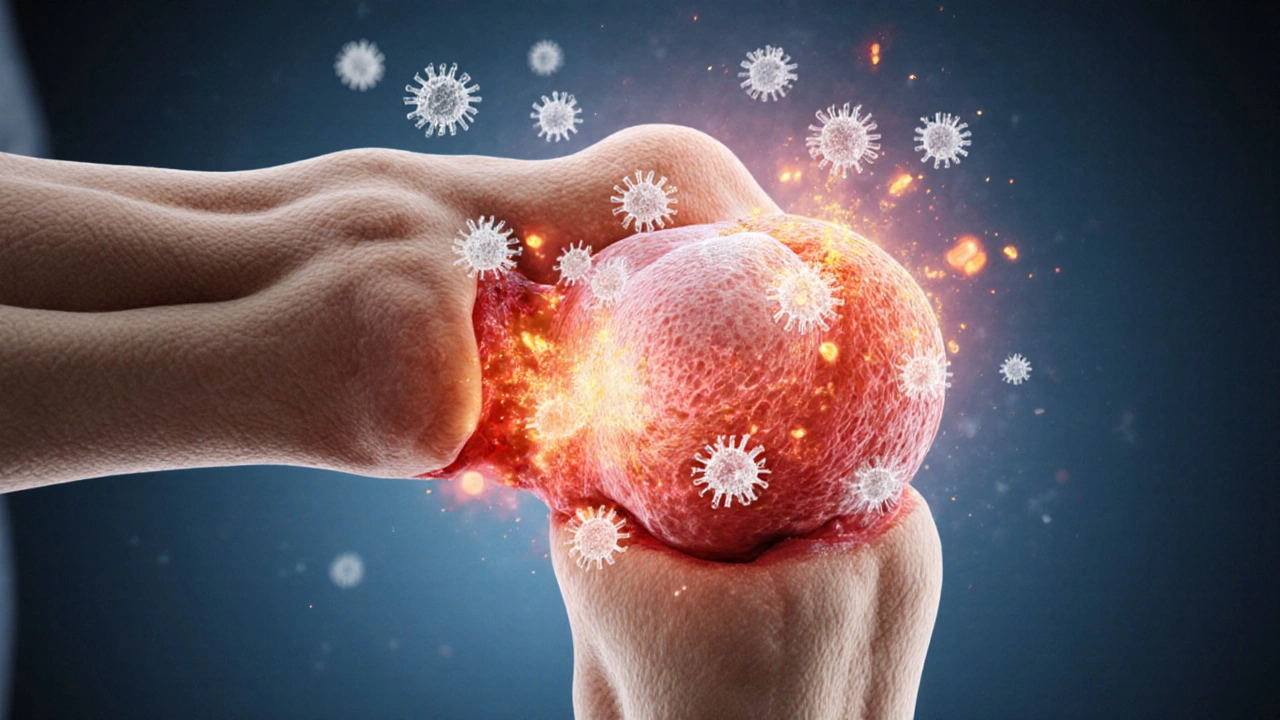 Oct, 12 2025
Oct, 12 2025
RA Disease Activity Calculator (DAS28)
DAS28 Disease Activity Score Calculator
Calculate your Rheumatoid Arthritis Disease Activity Score using the DAS28 system, which combines tender joints, swollen joints, pain, and inflammatory markers.
Understanding Rheumatoid arthritis means knowing why the immune system turns against your own joints and what you can do to keep life moving.
Key Takeaways
- Rheumatoid arthritis (RA) is an autoimmune disease that attacks the synovial membrane, causing chronic joint inflammation.
- Both genetics and environment play roles; smoking and certain infections can trigger onset.
- Early symptoms include symmetric joint pain, morning stiffness, and fatigue.
- Treatment combines medication (DMARDs, biologics, JAK inhibitors), physical therapy, and lifestyle changes.
- Monitoring inflammatory markers like C‑reactive protein (CRP) helps track disease activity.
What Is Rheumatoid Arthritis?
When we discuss this condition, Rheumatoid arthritis is a chronic autoimmune disease that primarily attacks the lining of joints, known as the synovium, leading to swelling, pain, and eventual joint damage. Unlike osteoarthritis, which results from wear and tear, RA stems from a misdirected immune response.
How Autoimmunity Drives Joint Damage
RA belongs to a broader group of autoimmune diseases that cause the body’s immune system to mistakenly target its own tissues. In RA, immune cells release inflammatory cytokines that inflame the synovial membrane (or synovium), thickening it and creating pannus tissue that erodes cartilage and bone.
Why Some People Get RA: Genetics and Triggers
Research shows a strong genetic predisposition that increases susceptibility to rheumatoid arthritis, especially certain HLA‑DRB1 alleles known as the "shared epitope". However, genetics alone isn’t enough; environmental factors act as accelerators.
Key environmental triggers include cigarette smoking, silica dust exposure, and infections such as Epstein‑Barr virus. Smoking, in particular, interacts with the shared epitope to raise risk up to threefold.

Spotting the Early Signs
Symptoms often start subtly and progress over months. Look for these patterns:
- Symmetric joint pain-usually affecting the wrists, MCP (metacarpophalangeal), and PIP (proximal interphalangeal) joints.
- Morning stiffness lasting more than 30 minutes.
- Swollen, warm joints that feel tender to the touch.
- Systemic clues such as fatigue, low‑grade fever, and unexplained weight loss.
Blood tests can reveal elevated inflammatory markers, especially C‑reactive protein (CRP) and erythrocyte sedimentation rate (ESR). Positive rheumatoid factor (RF) or anti‑CCP antibodies further support the diagnosis.
Diagnosing RA: From Clinical Exam to Imaging
Doctors combine patient history, physical exam, labs, and imaging. Ultrasound and MRI can detect early synovitis before X‑rays show erosion. Early diagnosis matters because prompt treatment can halt irreversible joint damage.
Medication Arsenal: How Treatments Work
The goal is to suppress inflammation, prevent structural damage, and maintain function. Below is a quick comparison of the main drug classes.
| Class | Mechanism | Onset of Action | Typical Side Effects | Cost (USD/year) |
|---|---|---|---|---|
| NSAIDs | Inhibit COX enzymes, reducing prostaglandin‑mediated inflammation | Hours to days | GI irritation, cardiovascular risk | ~$150‑$500 |
| DMARDs (Disease‑Modifying Antirheumatic Drugs) | Modulate immune response, slow joint damage | Weeks to months | Liver toxicity, bone marrow suppression | ~$1,200‑$3,000 |
| Biologic therapy | Target specific cytokines (TNF‑α, IL‑6, etc.) | Days to weeks | Infection risk, injection reactions | ~$20,000‑$45,000 |
| JAK inhibitors | Block Janus kinase pathways that drive inflammation | Days | Elevated lipids, herpes zoster | ~$15,000‑$30,000 |
Among these, DMARDs remain the cornerstone because they alter disease progression rather than just mask pain. Methotrexate is the most prescribed first‑line DMARD, given weekly at low doses.
If methotrexate alone isn’t enough, doctors may add a biologic therapy such as adalimumab (TNF inhibitor) or tocilizumab (IL‑6 receptor blocker). For patients who can’t tolerate biologics, JAK inhibitors like tofacitinib offer an oral alternative.
Beyond Pills: Rehabilitation and Lifestyle
Medication works best when paired with non‑pharmacologic strategies.
- Physical therapy focuses on maintaining joint range of motion, strengthening muscles, and teaching joint‑protective techniques.
- Regular low‑impact exercise-swimming, cycling, or walking-reduces stiffness and improves cardiovascular health.
- Weight management eases load on weight‑bearing joints, which can slow progression.
- Smoking cessation is critical; quitting can halve the risk of severe disease flares.
- Balanced diet rich in omega‑3 fatty acids (e.g., fish, flaxseed) may modestly lower inflammatory markers.

Monitoring Disease Activity
Doctors use the DAS28 (Disease Activity Score) that combines joint counts, patient‑reported pain, and CRP levels. A score below 2.6 indicates remission, 2.6‑3.2 low disease activity, and above 5.1 high activity.
Regular labs (CBC, liver enzymes, CRP) ensure medications remain safe. Adjustments are made when side effects emerge or disease activity rises.
Living with RA: Practical Tips
- Schedule rheumatology appointments every 3-6 months, even when you feel fine.
- Keep a symptom diary-note joint pain, stiffness duration, and triggers.
- Use assistive devices (e.g., jar openers, button hooks) during flare‑ups to protect joints.
- Plan ahead for work: discuss flexible hours or remote options with your employer.
- Stay connected with support groups; sharing experiences reduces isolation.
When to Seek Immediate Care
If you notice sudden worsening of joint swelling, fever, or new neurological symptoms (e.g., numbness), call your rheumatologist promptly. These could signal an infection or severe flare that needs urgent treatment.
Frequently Asked Questions
Can rheumatoid arthritis be cured?
There is no cure yet, but early and aggressive treatment can put many patients into remission and prevent permanent joint damage.
Is rheumatoid arthritis hereditary?
Family history raises risk, especially if close relatives have RA, but an individual gene alone does not guarantee the disease.
What lifestyle changes help manage RA?
Quit smoking, maintain a healthy weight, engage in regular low‑impact exercise, and follow an anti‑inflammatory diet rich in omega‑3s.
How often should I have blood tests while on methotrexate?
Typically every 4-8 weeks to monitor liver function, blood counts, and kidney health.
Are biologic therapies safe during pregnancy?
Some biologics, like certolizumab, have limited placental transfer and may be used under specialist guidance; others are avoided.
Heather Jackson
October 12, 2025 AT 05:18I was scrolling through my feed when this hit me like a ton of confetti. RA ain't just a buzzword, it can wreck lives, especially when the joint pain hits at 2 am and you can’t even zip up your favorite jeans. I’ve seen friends struggle with the fatigue and the meds, so kudos for breaking it down in plain words.
Akshay Pure
October 12, 2025 AT 21:58One must acknowledge the oversimplified narrative that equates rheumatoid arthritis merely with "aches and pains." The immunopathogenesis is far more intricate, involving cytokine cascades, synovial hyperplasia, and genetic predisposition. Reducing it to a checklist, while pedagogically convenient, risks trivializing a disease that demands nuanced therapeutic strategies.
Steven Macy
October 13, 2025 AT 14:38Living with RA feels like dancing on a floor that shifts beneath you-one moment steady, the next a jolt of pain. It teaches patience, because you learn to listen to your body’s whispers before they become shouts. The article’s breakdown of DAS28 is useful; knowing your score can empower you to have a more informed chat with your rheumatologist.
Artie Alex
October 14, 2025 AT 07:18From a mechanistic standpoint, the DAS28 algorithm integrates both subjective and objective parameters, thereby offering a composite index of disease activity. The inclusion of C‑reactive protein (CRP) as an inflammatory biomarker augments the model's predictive validity, especially in seropositive cohorts. Nevertheless, clinicians must remain vigilant to the heterogeneity of patient responses, as equivocal scores may mask subclinical synovitis detectable only via ultrasonography.
abigail loterina
October 14, 2025 AT 23:58Great job explaining the basics! If you’re new to RA, start by keeping a symptom diary – note pain levels, swollen joints, and how you feel each day. Sharing that with your doctor can really help tailor the treatment plan.
Roger Cole
October 15, 2025 AT 16:38Your info is spot on.
Chris Wiseman
October 16, 2025 AT 09:18Interesting take, but let’s not overlook the psychosocial dimension that most calculators ignore. While DAS28 quantifies joint involvement, it neglects the emotional toll, which can modulate inflammatory pathways via the hypothalamic‑pituitary‑adrenal axis.
Patients often report mood swings, fatigue, and sleep disturbances that aren’t captured by tender/swollen counts or CRP alone.
Moreover, the binary thresholds for remission versus low disease activity are somewhat arbitrary; a patient hovering at 2.7 may feel vastly different from someone at 2.5.
In practice, shared decision‑making should incorporate patient‑reported outcomes alongside the numeric score.
In short, the tool is valuable, yet it is merely one piece of a larger therapeutic puzzle.
alan garcia petra
October 17, 2025 AT 01:58Hey, love the positive vibe! If you’re feeling dragged down by flare‑ups, remember that regular low‑impact exercise can boost joint flexibility and cut down stiffness.
Even a short walk or gentle yoga session can make a noticeable difference.
Francisco Garcia
October 17, 2025 AT 18:38From a cultural perspective, many communities still view chronic illnesses like RA through a stigma lens. It's crucial to spread awareness that early detection and treatment can dramatically improve quality of life.
Sharing personal stories helps break down those barriers.
Patrick Renneker
October 18, 2025 AT 11:18Whilst the exposition offers a commendable overview, one must interrogate the epistemological foundations of the DAS28 metric. Does it truly encapsulate the multi‑dimensional nature of rheumatoid pathology, or does it merely reduce a complex syndrome to a convenient numerical façade?
KAYLEE MCDONALD
October 19, 2025 AT 03:58Thanks for the clear summary. I’ll definitely try the calculator to see where I stand.
Alec McCoy
October 19, 2025 AT 20:38What a solid foundation you’ve laid! For anyone just starting out, consider joining a local RA support group – the shared experiences can be incredibly uplifting, and you’ll pick up tips on managing daily challenges.
Aaron Perez
October 20, 2025 AT 13:18Ah, the perennial quest for knowledge-let us pause and contemplate the philosophical implications of quantifying suffering!; Indeed, the DAS28 score endeavors to translate the ineffable experience of pain into a decimal; Yet, does this numeric reduction honor the lived reality of the patient, or does it veil the nuanced tapestry of their existence?
Consider the paradox: a patient with a DAS28 of 2.5 may report relentless fatigue, whereas another with 3.0 may feel comparatively vibrant.
Thus, our reliance on such metrics may inadvertently prioritize statistical conformity over individualized care; This is not merely a clinical quandary but an ethical one.
The clinician, armed with the score, must exercise discernment, inviting the patient into a dialogic process where numbers serve as guides, not dictators.
Furthermore, the inflammatory markers-CRP and ESR-are themselves subject to fluctuations unrelated to joint pathology, such as infections or stress.
Hence, a holistic assessment must integrate psychosocial dimensions, co‑morbidities, and personal goals.
In summation, while the DAS28 provides valuable insight, it remains a fragment of the grand mosaic that constitutes patient health.
Ashleigh Connell
October 21, 2025 AT 05:58I appreciate the balanced tone here. It’s refreshing to see medical info presented without alarmism, which can help readers feel more in control of their health journey.
Erin Knight
October 21, 2025 AT 22:38Honestly, the piece reads like a textbook summary-nothing groundbreaking. Still, it covers the basics, so if you’re clueless, it does the job.
Kavita Jadhav
October 22, 2025 AT 15:18Such a concise guide, but don’t let brevity fool you-RA management is a marathon, not a sprint. Keep pushing forward, and don’t hesitate to ask your doctor about newer biologic options if traditional meds fall short.
Tony Halstead
October 23, 2025 AT 07:58Excellent synthesis! For those curious about the underlying mechanisms, remember that autoantibodies like rheumatoid factor and anti‑CCP play pivotal roles in disease progression, and early detection of these markers can guide more aggressive therapy before irreversible joint damage sets in.
leo dwi putra
October 24, 2025 AT 00:38Wow, this article really hits the mark! I’ve been battling RA for years, and the DAS28 calculator feels like a crystal ball-finally, I can see my disease activity quantified, not just guessed.
Krista Evans
October 24, 2025 AT 17:18Super helpful! I’m going to try plugging my numbers in tonight and see where I stand. Thanks for making this stuff easy to understand.